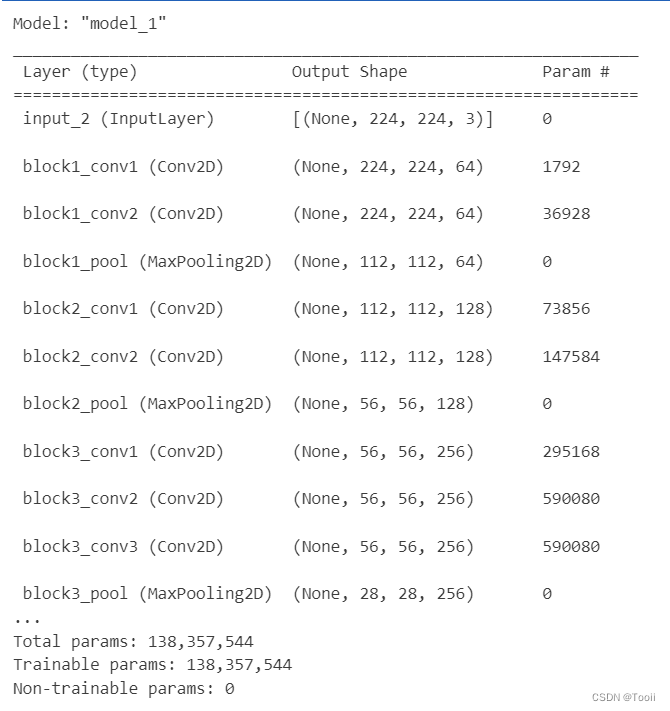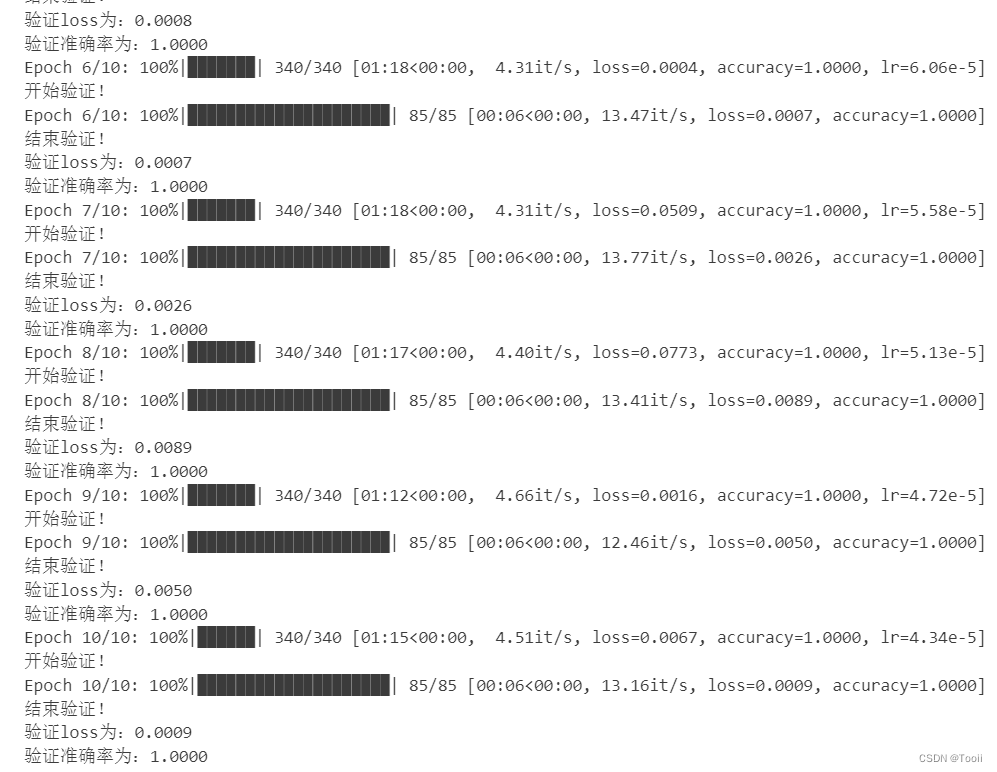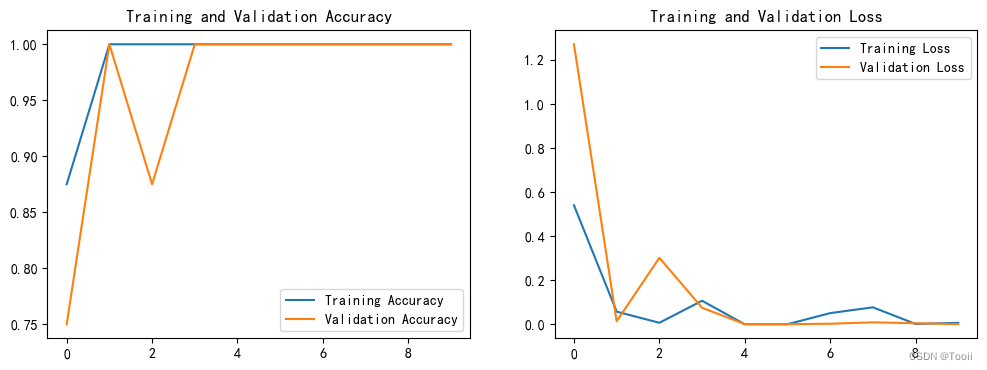- 🍨 本文为🔗365天深度学习训练营 中的学习记录博客
- 🍖 原作者:K同学啊
一、前期工作
1. 设置GPU
import tensorflow as tf
gpus = tf.config.list_physical_devices("GPU")
if gpus:
tf.config.experimental.set_memory_growth(gpus[0], True) #设置GPU显存用量按需使用
tf.config.set_visible_devices([gpus[0]],"GPU")
# 打印显卡信息,确认GPU可用
print(gpus)
2. 导入数据
import matplotlib.pyplot as plt
# 支持中文
plt.rcParams['font.sans-serif'] = ['SimHei'] # 用来正常显示中文标签
plt.rcParams['axes.unicode_minus'] = False # 用来正常显示负号
import os,PIL,pathlib
#隐藏警告
import warnings
warnings.filterwarnings('ignore')
data_dir = "F:/host/Data/猫狗识别数据/"
data_dir = pathlib.Path(data_dir)
image_count = len(list(data_dir.glob('*/*')))
print("图片总数为:",image_count)

二、数据预处理
1. 加载数据
使用image_dataset_from_directory方法将磁盘中的数据加载到tf.data.Dataset中
batch_size = 8
img_height = 224
img_width = 224
train_ds = tf.keras.preprocessing.image_dataset_from_directory(
data_dir,
validation_split=0.2,
subset="training",
seed=12,
image_size=(img_height, img_width),
batch_size=batch_size)
val_ds = tf.keras.preprocessing.image_dataset_from_directory(
data_dir,
validation_split=0.2,
subset="validation",
seed=12,
image_size=(img_height, img_width),
batch_size=batch_size)
class_names = train_ds.class_names
print(class_names)

2. 再次检查数据
Image_batch是形状的张量(8, 224, 224, 3)。这是一批形状224x224x3的8张图片(最后一维指的是彩色通道RGB)。Label_batch是形状(8,)的张量,这些标签对应8张图片
for image_batch, labels_batch in train_ds:
print(image_batch.shape)
print(labels_batch.shape)
break

3. 配置数据集
- shuffle() : 打乱数据,关于此函数的详细介绍可以参考:https://zhuanlan.zhihu.com/p/42417456
- prefetch() :预取数据,加速运行,其详细介绍可以参考我前两篇文章,里面都有讲解。
- cache() :将数据集缓存到内存当中,加速运行
AUTOTUNE = tf.data.AUTOTUNE
def preprocess_image(image,label):
return (image/255.0,label)
# 归一化处理
train_ds = train_ds.map(preprocess_image, num_parallel_calls=AUTOTUNE)
val_ds = val_ds.map(preprocess_image, num_parallel_calls=AUTOTUNE)
train_ds = train_ds.cache().shuffle(1000).prefetch(buffer_size=AUTOTUNE)
val_ds = val_ds.cache().prefetch(buffer_size=AUTOTUNE)
4. 可视化数据
plt.figure(figsize=(15, 10)) # 图形的宽为15高为10
for images, labels in train_ds.take(1):
for i in range(8):
ax = plt.subplot(5, 8, i + 1)
plt.imshow(images[i])
plt.title(class_names[labels[i]])
plt.axis("off")

三、构建VGG-16网络
from tensorflow.keras import layers, models, Input
from tensorflow.keras.models import Model
from tensorflow.keras.layers import Conv2D, MaxPooling2D, Dense, Flatten, Dropout
def VGG16(nb_classes, input_shape):
input_tensor = Input(shape=input_shape)
# 1st block
x = Conv2D(64, (3,3), activation='relu', padding='same',name='block1_conv1')(input_tensor)
x = Conv2D(64, (3,3), activation='relu', padding='same',name='block1_conv2')(x)
x = MaxPooling2D((2,2), strides=(2,2), name = 'block1_pool')(x)
# 2nd block
x = Conv2D(128, (3,3), activation='relu', padding='same',name='block2_conv1')(x)
x = Conv2D(128, (3,3), activation='relu', padding='same',name='block2_conv2')(x)
x = MaxPooling2D((2,2), strides=(2,2), name = 'block2_pool')(x)
# 3rd block
x = Conv2D(256, (3,3), activation='relu', padding='same',name='block3_conv1')(x)
x = Conv2D(256, (3,3), activation='relu', padding='same',name='block3_conv2')(x)
x = Conv2D(256, (3,3), activation='relu', padding='same',name='block3_conv3')(x)
x = MaxPooling2D((2,2), strides=(2,2), name = 'block3_pool')(x)
# 4th block
x = Conv2D(512, (3,3), activation='relu', padding='same',name='block4_conv1')(x)
x = Conv2D(512, (3,3), activation='relu', padding='same',name='block4_conv2')(x)
x = Conv2D(512, (3,3), activation='relu', padding='same',name='block4_conv3')(x)
x = MaxPooling2D((2,2), strides=(2,2), name = 'block4_pool')(x)
# 5th block
x = Conv2D(512, (3,3), activation='relu', padding='same',name='block5_conv1')(x)
x = Conv2D(512, (3,3), activation='relu', padding='same',name='block5_conv2')(x)
x = Conv2D(512, (3,3), activation='relu', padding='same',name='block5_conv3')(x)
x = MaxPooling2D((2,2), strides=(2,2), name = 'block5_pool')(x)
# full connection
x = Flatten()(x)
x = Dense(4096, activation='relu', name='fc1')(x)
x = Dense(4096, activation='relu', name='fc2')(x)
output_tensor = Dense(nb_classes, activation='softmax', name='predictions')(x)
model = Model(input_tensor, output_tensor)
return model
model=VGG16(1000, (img_width, img_height, 3))
model.summary()

四、编译
在准备对模型进行训练之前,还需要再对其进行一些设置。以下内容是在模型的编译步骤中添加的:
- 损失函数(loss):用于衡量模型在训练期间的准确率。
- 优化器(optimizer):决定模型如何根据其看到的数据和自身的损失函数进行更新。
- 评价函数(metrics):用于监控训练和测试步骤。以下示例使用了准确率,即被正确分类的图像的比率。
model.compile(optimizer="adam",
loss ='sparse_categorical_crossentropy',
metrics =['accuracy'])
五、训练模型
from tqdm import tqdm
import tensorflow.keras.backend as K
epochs = 10
lr = 1e-4
# 记录训练数据,方便后面的分析
history_train_loss = []
history_train_accuracy = []
history_val_loss = []
history_val_accuracy = []
for epoch in range(epochs):
train_total = len(train_ds)
val_total = len(val_ds)
"""
total:预期的迭代数目
ncols:控制进度条宽度
mininterval:进度更新最小间隔,以秒为单位(默认值:0.1)
"""
with tqdm(total=train_total, desc=f'Epoch {epoch + 1}/{epochs}',mininterval=1,ncols=100) as pbar:
lr = lr*0.92
K.set_value(model.optimizer.lr, lr)
for image,label in train_ds:
"""
训练模型,简单理解train_on_batch就是:它是比model.fit()更高级的一个用法
想详细了解 train_on_batch 的同学,
可以看看我的这篇文章:https://www.yuque.com/mingtian-fkmxf/hv4lcq/ztt4gy
"""
history = model.train_on_batch(image,label)
train_loss = history[0]
train_accuracy = history[1]
pbar.set_postfix({"loss": "%.4f"%train_loss,
"accuracy":"%.4f"%train_accuracy,
"lr": K.get_value(model.optimizer.lr)})
pbar.update(1)
history_train_loss.append(train_loss)
history_train_accuracy.append(train_accuracy)
print('开始验证!')
with tqdm(total=val_total, desc=f'Epoch {epoch + 1}/{epochs}',mininterval=0.3,ncols=100) as pbar:
for image,label in val_ds:
history = model.test_on_batch(image,label)
val_loss = history[0]
val_accuracy = history[1]
pbar.set_postfix({"loss": "%.4f"%val_loss,
"accuracy":"%.4f"%val_accuracy})
pbar.update(1)
history_val_loss.append(val_loss)
history_val_accuracy.append(val_accuracy)
print('结束验证!')
print("验证loss为:%.4f"%val_loss)
print("验证准确率为:%.4f"%val_accuracy)

六、模型评估
epochs_range = range(epochs)
plt.figure(figsize=(12, 4))
plt.subplot(1, 2, 1)
plt.plot(epochs_range, history_train_accuracy, label='Training Accuracy')
plt.plot(epochs_range, history_val_accuracy, label='Validation Accuracy')
plt.legend(loc='lower right')
plt.title('Training and Validation Accuracy')
plt.subplot(1, 2, 2)
plt.plot(epochs_range, history_train_loss, label='Training Loss')
plt.plot(epochs_range, history_val_loss, label='Validation Loss')
plt.legend(loc='upper right')
plt.title('Training and Validation Loss')
plt.show()

七、预测
import numpy as np
# 采用加载的模型(new_model)来看预测结果
plt.figure(figsize=(18, 3)) # 图形的宽为18高为5
plt.suptitle("预测结果展示")
for images, labels in val_ds.take(1):
for i in range(8):
ax = plt.subplot(1,8, i + 1)
# 显示图片
plt.imshow(images[i].numpy())
# 需要给图片增加一个维度
img_array = tf.expand_dims(images[i], 0)
# 使用模型预测图片中的人物
predictions = model.predict(img_array)
plt.title(class_names[np.argmax(predictions)])
plt.axis("off")

八、个人小结
通过本次实践,我对使用TensorFlow进行深度学习图像分类任务有了更深入的理解。从设置GPU资源、导入和预处理数据,到构建、训练和评估VGG-16网络模型,整个过程让我对深度学习的工作流程有了更加清晰的认识。






















 1423
1423











 被折叠的 条评论
为什么被折叠?
被折叠的 条评论
为什么被折叠?








